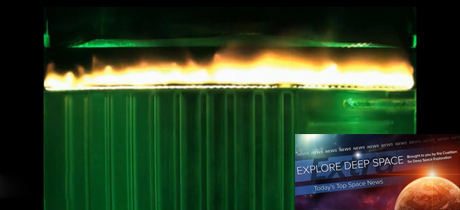In Today’s Deep Space Extra… NASA’s effort to prepare for future human deep space exploration includes fire prevention and setting new radiation limits for astronauts. Could space greenhouses solve the Earth’s food crisis?
Human Space Exploration
Watch NASA light a fire on a spaceship on purpose. You know, for science.
Coalition Member in the News – Northrop Grumman
Space.com (2/11): After it departed the International Space Station (ISS) on January 6, a Northrop Grumman Cygnus cargo capsule hosted the latest in a series of five fire in space experiments. The findings intend to improve the safety of future human missions through fire prevention and cleanup. The pressure and oxygen concentration in the capsule, which was filled with trash as it departed the ISS, were set to match those of a future space habitat.
NASA SLS computer development branching to support first flight, future upgrades
Coalition Member in the News – Boeing
NASASpaceflight.com (2/11): Following completion of certification testing in October 2020 of the computer system for the first launch of NASA’s Space Launch System (SLS) rocket – the Artemis I mission– teams are now working on upgrades for future flights and vehicle configurations.
NASA wants to set a new radiation limit for astronauts
Wired.com (2/11): As NASA looks to longer deep space missions for its astronaut corps, the agency is thinking of raising the radiation exposure limit. Exposure to radiation in space from the sun and other sources can carry a risk of health issues, more so for women than men. The current limit of 400 millisieverts (mSv) for men, 120 mSv for women could be raised to 600 mSv for both genders.
Space Science
NASA to use commercial launch vehicle for Europa Clipper
SpaceNews.com (2/11): NASA’s Europa Clipper mission, a multiple flyby mission to further assess the habitability of Europa, the ice-covered moon of Jupiter, is no longer considering launching the Europa Clipper probe on the Space Launch System, deciding instead to launch the spacecraft on a commercial rocket it will procure in the next year.
Bill Nye implores Biden to protect Earth from dangerous asteroids
Futurism (2/10): The Planetary Society’s Bill Nye has called on the Biden Administration to invest more on science, including on planetary defense. Planetary defense is the identification and tracking of asteroids and comets that could pose an impact threat to the Earth and efforts to devise the technologies to prevent a catastrophic encounter. With link to video link to Nye’s open letter released Wednesday.
Other News
Could space greenhouses solve Earth’s food crisis?
Coalition Member in the News – Nanoracks
Space.com (2/12): Commercial space services company Nanoracks plans to use orbiting greenhouses to create super-resilient crops that would thrive in the harshest environments on Earth and help to ward off the food crisis that could result from climate change. The company hopes that at the end of 2021 it will be able to send the first related research to the ISS. Nanoracks might set up a small greenhouse in its Bishop Airlock, which became fully operational yesterday.
New Faces on Space Committees
POLITICO Space (2/12): The House and Senate committees that oversee NASA have both announced their full rosters, including several new faces. Three freshmen Democrats join the Senate Commerce Committee. On the House side, two new Democrats joined the House Science Committee this week. Brian Babin of Texas will continue to be the top Republican lawmaker on the panel’s space subcommittee. Democratic subcommittee chairs have not yet been decided.

